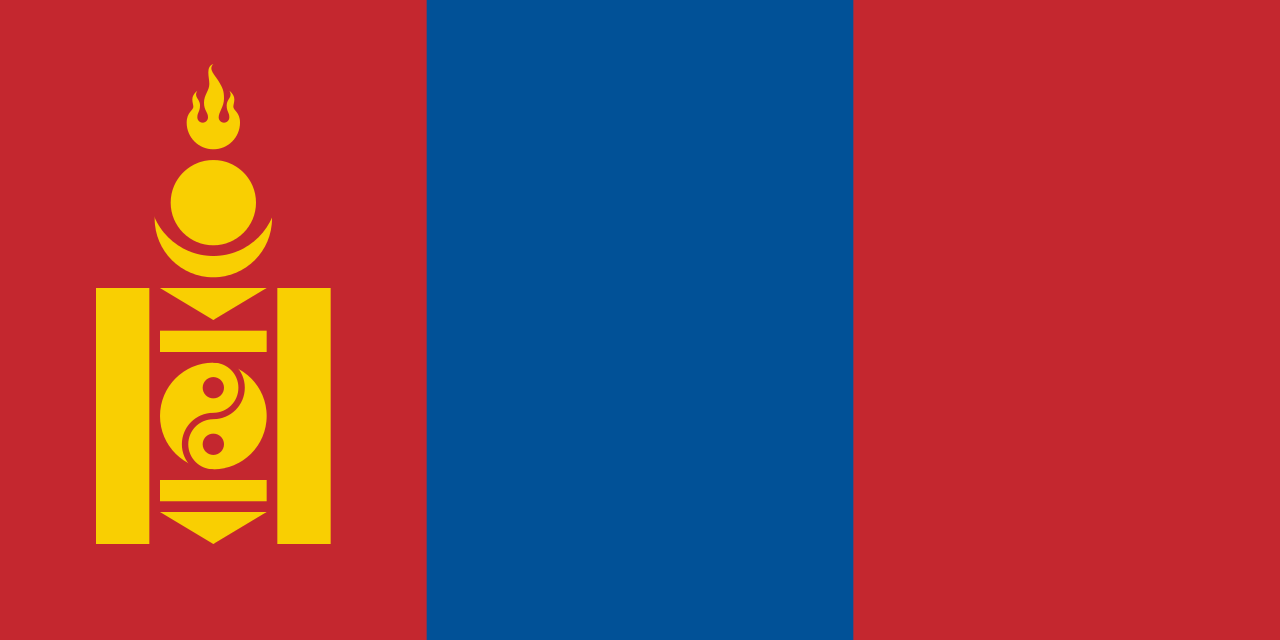Design and Symbolism:
The flag of Mongolia is composed of three vertical bands, with the outermost bands in a serene shade of blue and the central band in a vibrant red. These azure blue stripes are emblematic of the boundless Mongolian sky and evoke the expanse of the nation's sweeping landscapes. The blue hue also carries a spiritual connotation, representing the concept of eternal heaven and the optimistic aspirations of the Mongolian populace, reaching toward an illuminated and limitless future.
The central crimson stripe carries profound historical and cultural connotations. Red embodies the valor, fortitude, and gallantry embedded within the Mongolian lineage. It is a manifestation of the indomitable spirit that has animated the nation across the epochs, paying tribute to the sacrifices rendered by Mongolian warriors and protectors throughout history.
Emblazoned upon the red stripe, at its hoist side, resides the emblem renowned as the Soyombo. The Soyombo is an intricate and multifaceted symbol that unfolds layers of meaning:
- Fire: The apex of the Soyombo features a flame-like motif, symbolizing prosperity, perpetuity, and progress. It encapsulates the enduring and ever-evolving essence of the Mongolian populace.
- Sun: Beneath the flame, a circular sun emblem radiates, embodying the notion that Mongolia's existence will echo the enduring radiance of the sun, radiating its influence and cultural richness throughout the annals of time.
- Moon: Nestled below the sun, a crescent moon graces the emblem, symbolizing Mongolia's enduring essence akin to the moon's constancy, which guides and inspires generations.
- Triangles and Rectangles: The Soyombo encompasses several triangles and rectangles, each bearing distinctive significance. The triangular arrangements, fashioned into a fish-tail pattern, embody the harmony that arises from the fusion of opposites. The rectangular forms represent principles of integrity, justice, liberty, and unity.
- Triple Flame: The heart of the Soyombo is adorned with a triple-flame motif, a stylized representation of the Buddhist triad: the veracity of Buddha, the teachings promulgated by Buddha, and the congregation of devoted followers.
Historical Context:
The origins of the Soyombo emblem are steeped in history. It was conceived by Zanabazar (1635–1723), an esteemed spiritual leader, artist, and scholar who played a pivotal role in nurturing Mongolian culture and Buddhism. The emblem's presence across Mongolian art, literature, and sacred texts across centuries attests to its enduring significance. Its integration into the national flag symbolizes an unwavering connection to the country's heritage.
Adoption and Contemporary Significance:
The contemporary rendition of the Mongolian flag, complete with the Soyombo emblem, was formally embraced on February 12, 1992. This decision followed the democratic revolution that saw Mongolia's transition from a single-party socialist entity to a vibrant multi-party democracy.
In the present era, the flag serves as a unifying embodiment, encapsulating the ethos, chronicles, and ambitions of the Mongolian populace. It signifies the nation's dedication to safeguarding its cultural identity while embracing progress and innovation.
In summation, the Mongolian flag harmoniously intertwines shades, forms, and symbols, encapsulating the quintessence of the nation's heritage, culture, and aspirations. Its profound significance renders it an emblem cherished deeply, pulsating with the stories and aspirations of the Mongolian people.
Last Updated on: August 18, 2025
